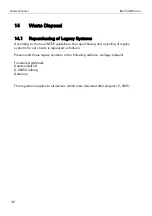
INSYS GPRS mini
Installation of the modem
ommend to use a cable antenna and place it away from the terminal. If signal
strength is weak, it is useful to face a directional antenna at the closest radio
base station. This can increase the strength of the signal received by the
modem. The modem’s peak output power can reach 2W. RF field strength
varies with antenna type and distance. At 10cm from the antenna the field
strength may be up to 70V/m and at 1m it will have reduced to 7V/m. In
general, CE-marked products for residential and commercial areas, and light
industry can withstand a minimum of 3V/m.
8.6.4
The antenna cable
Use 50
Ω
impedance low-loss cable and high-quality 50
Ω
impedance connec-
tors (frequency range up to 2GHz) to avoid RF losses. Ensure that the an-
tenna cable is as short as possible. The Voltage Standing-Wave Ratio
(VSWR) may depend on the effectiveness of the antenna, cable and connec-
tors. In addition, if you use an adapter between the antenna cable and the
antenna connector, it is crucial that the antenna cable is a high-quality, low-
loss cable. Minimize the use of extension cables, connectors and adapters.
Each additional cable, connector or adapter causes a loss of signal power.
8.6.5
Possible communications disturbances
Possible communication disturbances include the following:
Noise can be caused by electronic devices and radio transmitters.
Path-loss occurs as the strength of the received signal steadily de-
creases in proportion to the distance from the transmitter.
Shadowing is a form of environmental attenuation of radio signals
caused by hills, buildings, trees or even vehicles. This can be a particu-
lar problem inside buildings, especially if the walls are thick and rein-
forced.
Multi-path fading is a sudden decrease or increase in the signal
strength. This is the result of interference caused when direct and re-
flected signals reach the antenna simultaneously. Surfaces such as
buildings, streets, vehicles, etc., can reflect signals.
Hand-over occurs as you move from one cell to another in the GSM
network. Your mobile application call is transferred from one cell to
the next. Hand-over can briefly interfere with communication and may
cause a delay, or at worst, a disruption.
31











































